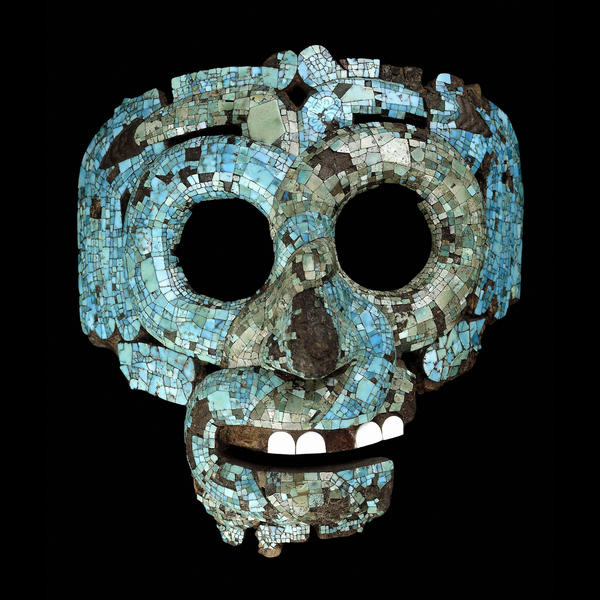 Introduction
to Archaeology and Palaeoanthropology:
Introduction
to Archaeology and Palaeoanthropology:
 Introduction
to Archaeology and Palaeoanthropology:
Introduction
to Archaeology and Palaeoanthropology:
Humanity's Journeys
Dr. Kathryn Denning
Anth 2140, Sept 2005 - Apr 2006
7 Mar 2006
Plan for the day
1 Course business/ announcements...
2 Ontario, Mesoamerica
Reading and Assignments
Tomorrow in tutorial - Quiz #5. Review notes here. And the beginnings of a video about the conquest of the Aztec.
Today's readings - Fagan Ch 14 and Ch 15, 364-416: Maize, Pueblos, and Mound Builders, and Mesoamerican Civilizations
Next week's readings
Fagan Ch 16 - 419-440 Andean Civilizations
Course Kit: Finding the Tomb of a Moche Priestess
This web reading about European contact and conquest in the Americas:
www.ucalgary.ca/applied_history/tutor/eurvoya/columbus.html, www.ucalgary.ca/applied_history/tutor/eurvoya/Latin.html,
www.ucalgary.ca/applied_history/tutor/eurvoya/aztec.html,
www.ucalgary.ca/applied_history/tutor/eurvoya/inca.html
www.ucalgary.ca/applied_history/tutor/eurvoya/maritime.html
www.ucalgary.ca/applied_history/tutor/eurvoya/eurowar.html
www.ucalgary.ca/applied_history/tutor/eurvoya/communicate.html
www.ucalgary.ca/applied_history/tutor/eurvoya/relex.html
Archaeology of Ontario
www.adamsheritage.com/pre/preont1.htm
Different groups, languages, lifeways
Changing landscapes and climate over time
Chronology
Glaciation
PalaeoIndian - 10 000 BCE and earlier
Archaic - Early, Middle, Late - around 8 000 to 1 000 BCE
Woodland - Early, Middle, Late - 1 000 BCE to 1000 AD/CE (pottery, farming)
Iroquoian - AD/CE 1000 - contact
Historic (contact) - Cartier 1534 onwards
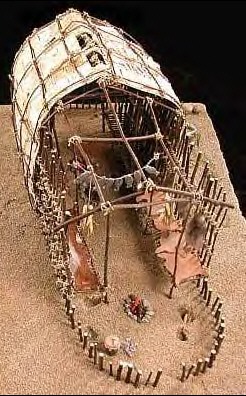
CURRENT MOHAWK TERRITORIES
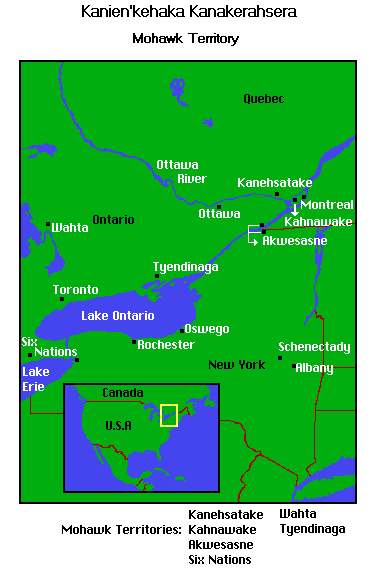
Links:
Seed-Barker site: http://www.rom.on.ca/digs/seedbarker/ http://www.chass.utoronto.ca/anthropology/Exhibit/seedbark.htm
Prehistory of Ontario www.adamsheritage.com/pre/preont1.htm
Iroquoian Longhouse: http://www.rom.on.ca/digs/longhouse/
ANCIENT NORTH AMERICA
Societies of great complexity but generally not designated "civilizations" (arbitrary?)
Gradual intensification, sedentism, and increasing population density...e.g. places like Koster and NW Coast
Others... adoption of agriculture... and specifically of maize (corn), which had been domesticated in Mexico and gradually brought north. Key Study: Richard MacNeish, Tehuacan valley shows the domestication of maize
Pueblo peoples (including Hohokam etc) - ancestral Pueblo formerly known as Anasazi
Chaco Canyon and surrounding areas -- essentially apartment buildings... e.g. Pueblo Bonito http://www.colorado.edu/Conferences/chaco/tour/bonito.htm Amazing astronomy... http://www.traditionsofthesun.org/
Hopewell peoples and other moundbuilders of the Northwest - Great Serpent Mound http://www.courtneymilne.com/html/serpentmound.html
Cahokia and the Mississippian http://www.cahokiamounds.com/virtual_tour.html
MESOAMERICA
Mesoamerica is a spatial region/geographic area, but also a region of cultural commonalities... cultural and linguistic. Long history of interaction between social groups in the region.
compare to the term "Western civilization"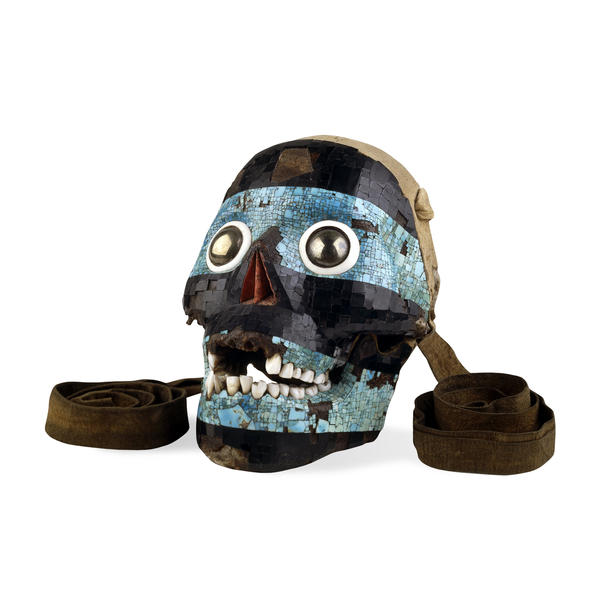
Olmec (1500-500 BC)
Ancient Maya (before 1000 BC to AD 1519)
Classic Maya (AD 300-900)
Teotihuacan (200 BC - AD 750)
Toltecs (AD 650-1200)
Aztec (AD 1200-1521)
The skull of the Smoking Mirror, British Museum. Aztec/Mixtec, 15th-16th century AD
"This mask is believed to represent the god Tezcatlipoca, one of the Aztec creator gods. He was also the god of rulers, warriors and sorcerers. His name can be translated as 'Smoking Mirror'. In fact, in many depictions during the Postclassic period (A.D. 900/1000-1521) his foot is replaced by a mirror.
The base for this mask is a human skull. Alternate bands of turquoise and lignite mosaic work cover the front of the skull. The eyes are made of two discs of iron pyrites set in rings made of shell. The back of the skull has been cut away and lined with leather. The jaw is movable and hinged on the leather." - BM
Space:
http://www.ancientmexico.com/content/map/index.html
maps here: http://www.famsi.org/research/pohl/index.html
Time
http://www.famsi.org/research/pohl/chronology.html
http://www.ancientmexico.com/content/timeline/
Timelines of ancient art and culture: specifically Mexico www.metmuseum.org/toah/ht/07/cam/ht07cam.htm
Some Major Sites:
http://www.famsi.org/research/pohl/pohl_sites.html
ARCHAEOLOGICALLY IDENTIFIABLE DEFINING TRAITS OF MESOAMERICA
subsistence - corn, beans, squash, horticulture, raised fields, cacao, amaranth, maguey
long-distance exchange - obsidian, cacao, jade
cosmology and ritual
- significant numbers 4, 5, 7, 9, 13, 20
- shared calendars: solar year = 18 months of 20 days each plus a set of 5 final days. 260 day ritual cycle of 13 day names combined with 20 numbers.
- use of writing and positional mathematics to record astronomy and calendar
- ritual warfare, special warrior costumes, human sacrifice
- specialized architecture for ritual... ball courts, temples, observatories
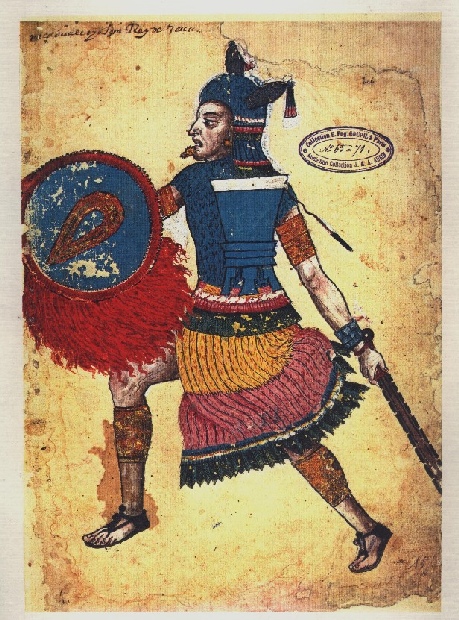
Nezahualcoyotl, ruler of Texcoco, 1431-1472. (Codex Ixtlilxochitl).
Note the obsidian blade in his hand.
Aztec lithics/weaponry: http://lithiccastinglab.com/gallery-pages/2003decemberaztecbifacespage1.htm
social stratification
status expressed in costumes, gendered dress, ornaments e.g. lip plugs, ear plugs
(labret e.g. from South America: http://personalwebs.coloradocollege.edu/~ctorresrouff/other/labret.html, nice Mesoamerican earplugs on this figure: http://www.jqjacobs.net/mesoamerica/images/izapa1.jpg )
- centralized city sites with ceremonial precincts, pyramids, temples, administrative centres, and ball courts
e.g. Teotihuacan http://www.famsi.org/research/pohl/sites/teotihuacan.html
n.b. the symbolic landscape and the residential areas.
The Temple of the Sun at Teotihuacan (Aztec, central Mexico)
Copyrighted photograph taken by
Clive
Ruggles
- the Ball Game
- Shared pantheon of gods, broadly speaking, who required similar things:
Bloodletting.
e.g. Olmec jade perforator.
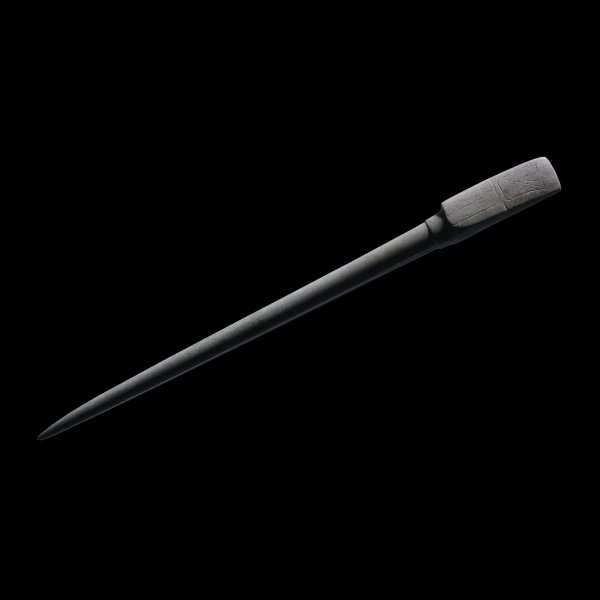
Olmec, 1200-400 BC
From Mexico
Perforators were used in self-sacrifice rites, which involved drawing blood from several parts of the body. Some representations of Olmec rulers show them holding bloodletters and/or sceptres as part of their elaborate ritual costume. Bloodletting was performed by the ruler to ensure the fertility of the land and the well-being of the community. It was also a means of communication with the ancestors and was vital to sustain the gods and the world. These rituals were common throughout Mesoamerica.
Olmec jade perforators are often found in graves as part of the funerary offerings. Bloodletting implements were also fashioned out of bone, flint, greenstones, stingray spines and shark teeth. They vary in form and symbolism. Handles can be plain, incised with a variety of symbols associated to certain deities, or carved into the shape of supernatural beings. The blades, ending in a sharp point, are sometimes shaped into the beaks of certain birds, such as the hummingbird, or into a stingray tail.
This large perforator was probably not used as a bloodletting instrument; it might have been placed in a grave as an offering, or may have served a symbolic function.
Height: 38 cm
Width: 3 cm
------------
(Bloodletting was a common practice in Maya life from the Late Preclassic period (400 BC - AD 250) onwards, and an essential part of rulership and of all public rituals. The Maya élite drew blood from various parts of their bodies using lancets made of stingray spine, flint, bone or obsidian. These objects are often found in burials and other archaeological contexts, though other perishable materials, like the rope and the bark-paper strips seen on the lintel, are now lost.) BM.
Human Sacrifice
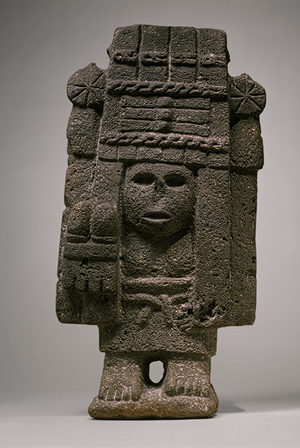
Maize Deity (Chicomecoatl),
15th–early 16th century
Mexico; Aztec. Basalt; H. 14 in. Metropolitan Museum of Art.
- annual sacrifice - blood poured on statue, priest wore skin
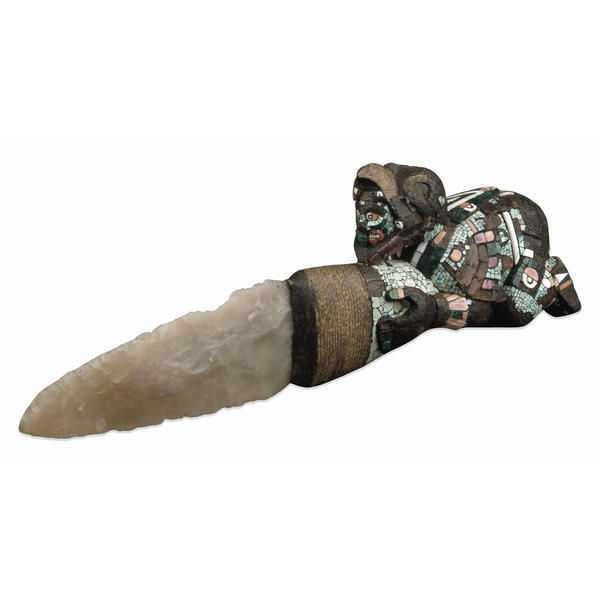
Knife with a mosaic handle and a chalcedony blade, Aztec/Mixtec, 15th-16th century AD, From Mexico, BM.
A sacrificial knife
"The handle of this knife is carved in wood and covered with mosaic of turquoise, shell and malachite. The blade is made of chalcedony.
The figure that forms the handle is an eagle warrior, a member of a prestigious order of Aztec warriors. The eagle plays an essential role in the legendary foundation of Tenochtitlan, the Aztec capital. According to the myth, the principal god Huitzilopochtli asked the Aztecs to found their city at the place where they saw an eagle perched upon a cactus. Excavations in the 1980s in Mexico City, which now covers the site on which Tenochtitlan was built, revealed a building later called the House of the Eagles. Two magnificent life-size ceramic sculptures representing eagle warriors were found in this building. The building was next to the Great Temple, the double pyramid dedicated to the Aztec gods Tlaloc and Huitzilopochtli.
An eagle perched on a cactus, with a serpent in its beak, is still today an important symbol in Mexico and appears on the national flag, banknotes and coins. " BM
Chacmool figure from El Templo Mayor
Copyrighted photograph taken by
Clive
Ruggles
Maya
Sources of information about the Maya:
- archaeology
- Mayan oral traditions; the culture is transformed, but traditional elements still survive
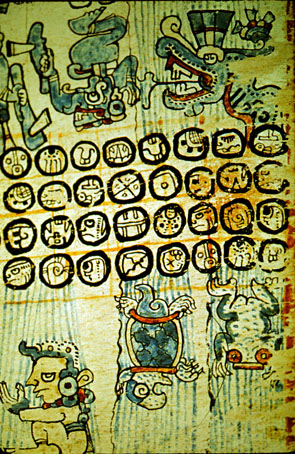 - traditional Mayan books, known as codices
(singular: codex) e.g. Madrid codex
- traditional Mayan books, known as codices
(singular: codex) e.g. Madrid codex
- inscriptions on buildings
- and missionaries e.g. Diego de Landa, with the Maya -- to whom we owe many narratives about the Maya... but also the destruction of almost all their religious books, not to mention the [Inquisitional] torture and murder of many Mayan people
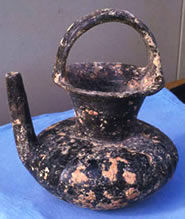 Favourite thing about
the Maya: earliest evidence of chocolate consumption! 2600 years ago, cocoa
residues found in ceramic vessels in northern Belize. Included cocoa in most
meals, mixing it with maize, chili, honey... and they knew the best part of hot
chocolate was the froth at the top!
Favourite thing about
the Maya: earliest evidence of chocolate consumption! 2600 years ago, cocoa
residues found in ceramic vessels in northern Belize. Included cocoa in most
meals, mixing it with maize, chili, honey... and they knew the best part of hot
chocolate was the froth at the top!
n.b. The Maya, though often portrayed as being earlier than other American civs, are still very much around, in Belize, Guatemala, Mexico. Often marginalized: e.g. Zapatista.
Mayan iconography.
E.g.s Yachilan lintels, below. Temple carvings from the 'Place of the Split Sky' - British Museum.
"Yaxchilán is located on the south bank of the Usumacinta River, in Chiapas, Mexico. It was a significant Maya centre during the Classic period (AD 250-900) and a number of its buildings stand to this day. Many of the exteriors had elaborate decorations, but it is the carved stone lintels above their doorways which have made this site famous. These lintels, commissioned by the rulers of the city, provide a lengthy dynastic record in both text and image.
Yaxchilán was founded in the Early Classic period (AD 250-600) but only underwent rapid growth in the Late Classic period (AD 600-800), under the reigns of Shield Jaguar II and his son Bird Jaguar IV.
Lintels 24, 25 and 26, set above the three doorways of Structure 23, depict a series of rituals performed by Shield Jaguar II and his wife. Structure 21, commissioned by Bird Jaguar IV, housed lintels 15, 16 and 17. Bird Jaguar was Yaxchilán's most prolific builder and at least a dozen major structures were initiated or remodelled during his reign." - BM
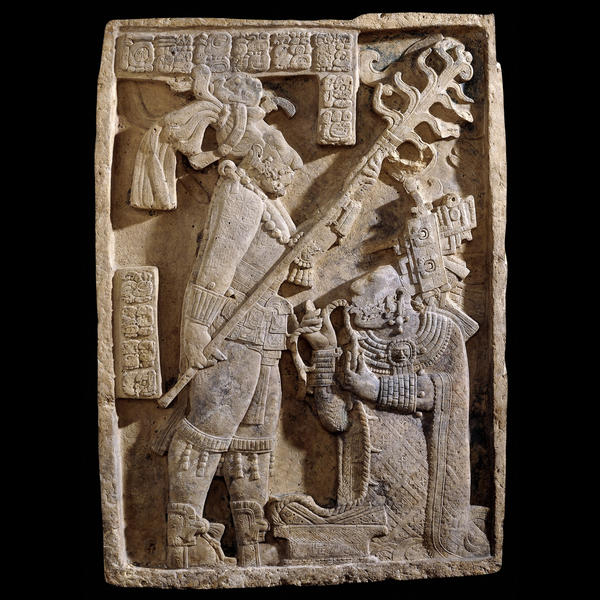
Above: Yaxchilan lintel 24, Maya, Late Classic
period (AD 600-900)
From Yaxchilán, Mexico - British Museum
A masterpiece of Maya art
"This limestone lintel, considered one of the masterpieces of Maya art, is one of a series of three panels from Structure 23 at Yaxchilán, where it was set above the left (south-east) doorway. Lintels 24 and 25, removed at Maudslay's request at the end of the nineteenth century, are on permanent display in The British Museum's Mexican Gallery. Lintel 26, the third in the series, is in the Museo Nacional de Antropología, in Mexico City.
The scene represents a bloodletting ritual performed by the king of Yaxchilán, Shield Jaguar II, and his wife, Lady K'ab'al Xook. The king holds a flaming torch over his wife, who is pulling a thorny rope through her tongue. Scrolls of blood can be seen around her mouth.
The first two glyphs in the text at the top of the lintel indicate the event and the date on which it took place, AD 709. The last glyph represents the Emblem Glyph (that is, the city name in Maya hierolglyphs) of Yaxchilán. The text on the left of the panel contains the name and titles of Lady K'ab'al Xook.
The lintel has traces of blue and red pigment." BM
-------
Below: Yaxchilán lintel 15, Maya, Late Classic period (AD 600-900), From Yaxchilán, Mexico, British Museum.
"A serpent apparition from a Maya temple
This limestone lintel is one of a series of three panels commissioned by Bird Jaguar IV for Structure 21 at Yaxchilán and was once set above the left (south-east) doorway of the central chamber.
The lintel shows one of Bird Jaguar's wives, Lady Wak Tuun, during a bloodletting rite. She is carrying a basket with the paraphernalia used for auto-sacrifice: a stingray spine, a rope and bloodied paper. The Vision Serpent appears before her, springing from a bowl, which also contains strips of bark-paper." BM
Joyce Marcus (Mesoamerican Writing Systems, p 299) notes this was: "apparently to commemorate the memory of an ancestor on the occasion of a temple dedication. The ancestor is visualized (at left) as a serpent who rises like billowing smoke fromt he blood-spattered papers the woman has deposited in the vessel below. In the jaws of this serpent we see the face of the deceased ancestor."
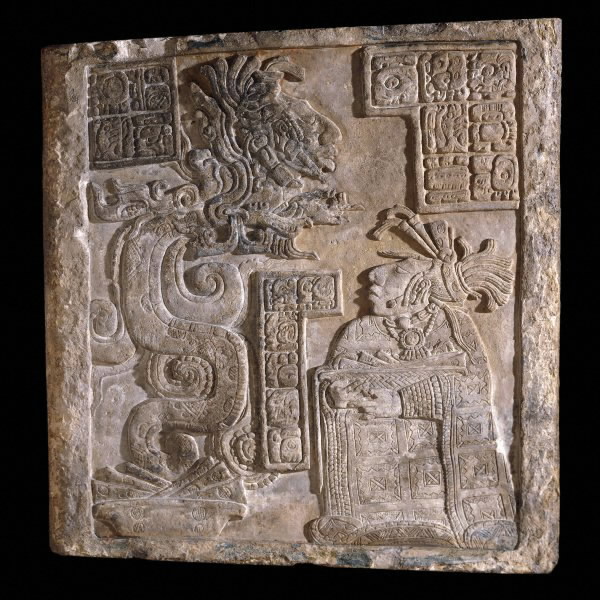
--------
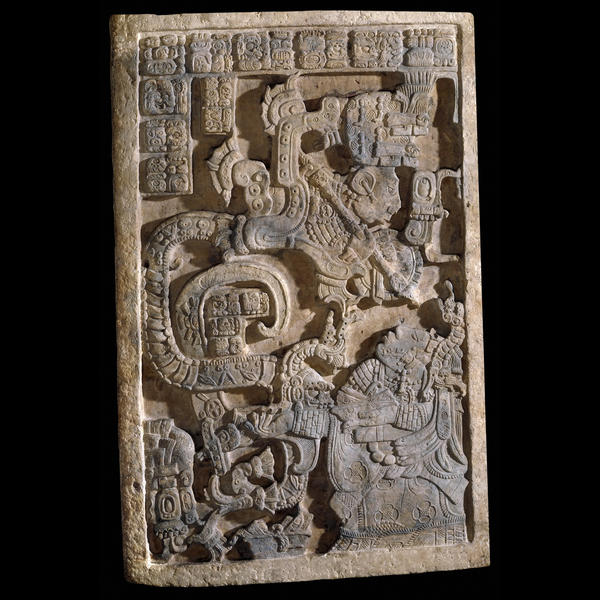
Yaxchilán lintel 25, Maya, Late Classic
period (AD 600-900)
From Yaxchilán, Mexico, BM
"This limestone lintel is one of a series of three panels from Structure 23 at Yaxchilán and was originally set above the central doorway.
The building is dedicated to Shield Jaguar II's wife, Lady K'ab'al Xook. It has particular significance since this was the first building to be constructed after a gap of over 150 years in the dynastic history of the city. It seems that the series of lintels was intended to convey a special message of the re-foundation of the site. Indeed, Shield Jaguar's building programme throughout the city may have been an attempt to reinforce his lineage and his right to rulership.
Lady Xook, on the bottom right of the panel, is in the hallucinatory stage of the bloodletting ritual. She conjures before her a vision of a Teotihuacan serpent. Some scholars suggest that the serpent on this lintel, and elsewhere, are depictions of an ancestral spirit or founder of the kingdom. The identity of the figure coming out of the serpent's jaws is ambiguous. The inscription names the protagonist as Shield Jaguar II.
The ritual is conducted to commemorate the accession of Shield Jaguar II to the throne. The inscription is reversed, as if to be read in a mirror. This is not common and its true significance is not known." BM
-------

Yaxchilán lintel 41, Maya, Late Classic period (AD 600-900), From Yaxchilán, Mexico
"This is the upper part of a limestone lintel found by A.P. Maudslay in front of the left (south) doorway of Structure 42. The lower section of the lintel is damaged.
Throughout the series of lintels set in Structure 42 Bird Jaguar IV commemorates his battles and other events to consolidate his power. These events emulate those enacted by his father, Shield Jaguar II. The various stages of warfare are shown in more detail at Yaxchilán than at any other Maya city. The scenes depicted are ritual preparations for war or the results of the battle.
Here, like Shield Jaguar on Lintel 26, Bird Jaguar is preparing for battle. One of his wives, a princess from the kingdom of Motul de San José, is presenting him with his spear.
The inscription tell us that this event took place in AD 755. The 'shell/star glyph', just above the lady's head-dress (bottom left), indicates war against a particular site. Her name and titles appear in front of her, while those of Bird Jaguar are represented by the fourth glyph in the sequence carved in front of him. " - BM.
------------
Maya hieroglyphic writing:
Mayan glyphs: http://www.famsi.org/mayawriting/dictionary/montgomery/index.html
Mayan codices: http://www.famsi.org/mayawriting/codices/
http://history.smsu.edu/jchuchiak/HST%20350--Maya_hierogolyphic_writing.htm
http://www.mayavase.com/coesyl/coesyl.html
http://pandora.cii.wwu.edu/vajda/ling201/writingsystems/mayaglyphs.htm
http://titan.glo.be/~kg000407/grammar1.htm
http://titan.glo.be/~kg000407/writing1.htm
The body
Head shaping and dental decoration among the ancient Maya: illustrations http://www.mesoweb.com/features/tiesler/index.html
More: http://www.uic.edu/classes/osci/osci590/6_1TheCulturalModificationOfTeeth.htm
The Aztec
- more properly the Mexica... (pronounced Mesheeka)
- as with the Inca, we know them through the lens of conquest, for the Aztec empire was in the ascendant when Cortes and the Spanish arrived.
Trying to see past the Conquest of 1519 is hard... for Tenochtitlan is literally underneath Mexico City
http://matthew.mumford.com/photos/mexico/large/06-Templo-Mayor.jpg, http://matthew.mumford.com/photos/mexico/large/12-Templo-Mayor.jpg
Tremendously complex culture... but with many institutions that we recognize today... think about the big picture of comparing civilizations
- Biases in what we know/think we know about them
Think about where our information comes from:
-Archaeology
-Accounts of the Spanish conquistadors themselves
-Aztec accounts -- written in traditional Aztec picture writing, and also in oral narratives written down in text post-conquest
-Oral history today.... still remembered
-And from missionaries, e.g. Bernardino de Sahagún
Who were the Aztec?
As Rosemary Joyce puts it: " 'Aztec' is the term that came into general use in European histories in the eighteenth century, to label the political power that united the largest part of Central America before the Spanish conquest in the sixteenth century. The word remains the conventional term to refer to this political power, and to the people who formed it.
But in fact the Aztec polity was made up of many different peoples [20 or so ethnic groups], an estimated fifty cities in the Valley of Mexico, and perhaps 250 others outside that area. Most discussions focus only on one of these peoples: the inhabitants of Tenochtitlan, who called themselves the Mexica. Along with many of their neighbours, they spoke and wrote in the Nahuatl language. Alone among those neighbours, they maintained a mythological tradition of origin and wandering as the chosen people of the patron god Huitzilopochtli."
it could also be called the Tenochca empire (after dwellers of Tenochtitlan)
Triple Alliance: Texcoco, Tlacopan, and Mexico (which consisted of twin cities of Tenochtitlan and Tlatelolco)
Sites: Tenochtitlan, the capital
http://www.ancientmexico.com/content/map/index.html http://www.ancientmexico.com/content/map/tenochtitlan.html
MAP of Tenochtitlan, from Cortes, 1524 http://www.famsi.org/research/pohl/images/aztec2figure01.jpg
"A map of Tenochtitlán made from Cortés’ personal memory and published in 1524. Despite the use of European artistic conventions, it features many accurate details. There were three major causeways that ran from the mainland into the city which was divided into four districts and populated by more than two hundred thousand people. In 1521, Cortés demolished the ceremonial center during the course of the longest continuous battle ever recorded in military history. Ancient Tenochtitlán was lost to memory."
Model of Tenochtitlan http://www.famsi.org/research/pohl/images/aztec2figure11.jpg
Excavation: http://www.famsi.org/research/pohl/images/aztec2figure09a.jpg
....but why were they living in the middle of a swamp, anyway?
The Origins of the Aztecs
- upstarts from the north - Aztlan
- deliberately obscured their own ancestry, actively appropriated older traditions e.g. from Teotihuacan and Tula (even carrying out excavations at Teotihuacan!)
Politics... the Aztecs weren't very good at making and keeping friends...
Religion: We tend to see the Aztec as rather brutal. Partly this is because of 'the lens of conquest', i.e. our descriptions come mostly through the 16th century Christian eyes of the Spanish.
Consider the Spanish religion at the time.
- one main deity, clearly not human.
- Christ / Crucifixion, Virgin Mary, saints, crusades...
- in crucial ways, diametrically opposed to Aztec religion: the correct thing to do with blood, with the body, correct modes of sacrifice...
e.g.s of Aztec Gods
Tezcatlipoca

BM
Aztec/Mixtec, 15th-16th century AD, From Mexico,
The skull of the Smoking Mirror, British Museum.
"This mask is believed to represent the god Tezcatlipoca, one of the Aztec creator gods. He was also the god of rulers, warriors and sorcerers. His name can be translated as 'Smoking Mirror'. In fact, in many depictions during the Postclassic period (A.D. 900/1000-1521) his foot is replaced by a mirror.
The base for this mask is a human skull. Alternate bands of turquoise and lignite mosaic work cover the front of the skull. The eyes are made of two discs of iron pyrites set in rings made of shell. The back of the skull has been cut away and lined with leather. The jaw is movable and hinged on the leather.
Turquoise was sent as tribute to the Aztec capital from several provinces of the empire. Some of those provinces were located in present-day Veracruz, Guerrero and Oaxaca. The turquoise was sent as raw chunks or as cut and polished mosaic tiles decorating a variety of objects, such as masks, shields, staffs, discs, knives and bracelets. We know from a tribute list issued by the emperor Motecuhzoma II that ten turquoise mosaic masks, made by skilled Mixtec artisans, were sent each year from a province in Oaxaca." - BM
---------
QUETZALCOATL

Mosaic mask of Quetzalcoatl
Aztec/Mixtec, 15th-16th century AD
From Mexico
The Feathered Serpent
This mask is believed to represent Quetzalcoatl or the Rain God Tlaloc, both associated with serpents. It is made of cedar wood and covered with turquoise mosaic work. The teeth are made of shell. Two serpents, one in green turquoise and one in blue, twist across the face and around the eyes, blending over the nose. Turquoise mosaic feathers hang on both sides of the eye sockets.
The Spanish friar Bernardino de Sahagún, writing in the sixteenth century, describes a mask like this one. It was a gift of the Aztec emperor Motecuhzoma II to the Spanish captain Hernán Cortés (1485-1547). The Aztec ruler thought that Cortés was the god Quetzalcoatl (Feathered Serpent) returning from the East. This mask was part of the adornments associated with this god. According to Sahagún's description it was worn with a crown of beautiful long greenish-blue iridescent feathers, probably those of the quetzal (a bird that lives in the tropical rain forest).
Though the Rain God Tlaloc was also sometimes represented with serpents twisting around his eyes, the feathers are more consistent with the image of Quetzalcoatl.
The earliest image of Quetzalcoatl as the Feathered Serpent appears at Teotihuacan in Central Mexico, on the façade of the temple that now bears his name.
Height: 17.3 cm
Width: 16.7 cm
----
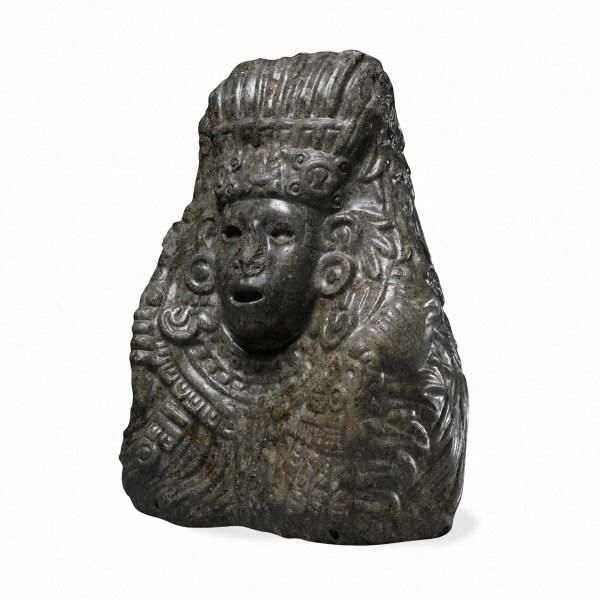
Stone bust of Quetzalcoatl
Aztec, AD 1325-1521
From Mexico
This sculpture represents the Aztec god Quetzalcoatl. His name in Nahuatl, the language spoken by the Aztecs, means Feathered (quetzal feather) Serpent. The serpent's coils of the sculpture are covered with feathers and the face of the god (or an impersonation) emerges wearing the curved shell ear ornaments characteristic of representations of this god.
The cult of Quetzalcoatl was widespread throughout Mesoamerica, although it was known by different names at different periods. While his various aspects and origins are far from clear, Quetzalcoatl is said to have been one of the Aztec creator gods.
According to the Aztec creation myth there were four suns or worlds before the present one, each of them created and destroyed in a different way. When the fourth sun was destroyed by floods the gods decided to create a new one. To create a new race of humans, Quetzalcoatl descended to the lower levels of the Underworld. He managed to trick Mictlantecuhtli and retrieved the bones of the people of the fourth sun. With those bones and some of his blood he gave life to the humans that inhabited the present world.
----------
XIPE TOTEC
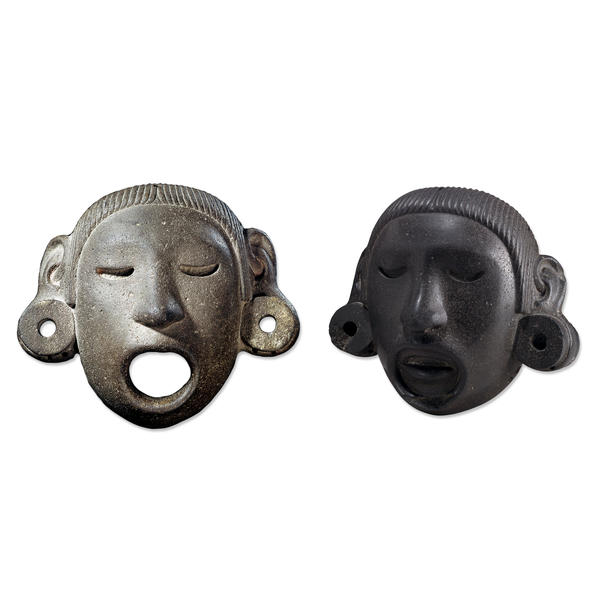
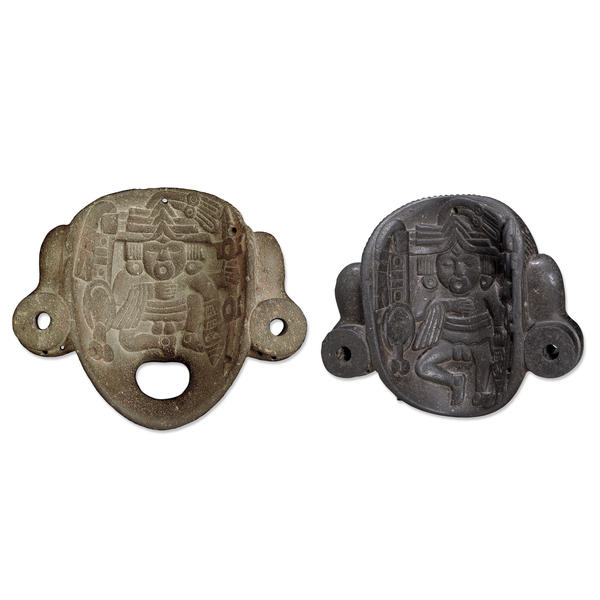
Xipe Totec.
Masks of Xipe Totec
From Mexico, possibly 19th century AD
These masks are intended to represent Xipe Totec, an Aztec god of fertility, usually represented wearing a flayed human skin.
Recent iconographic studies of the masks suggest that they may not be authentically Aztec in date. Some of the details of the scene on the back of both masks are not consistent with Aztec iconography. For example, the figure (representing Xipe Totec) has four arms and three of the hands are holding objects: a spear, a shield and a trophy head or incense bag. In authentic Aztec representations of Xipe Totec two of the hands are part of the flayed skin and therefore were never depicted holding objects. The frontal pose and the earplugs are also unusual in genuine images of the god.
While these masks could be an unusual example of Aztec art, it is also possible that they were made in the nineteenth century to satisfy a growing interest in Mexican art, especially by collectors and museums. Many pieces collected at the time and deposited in museums across America and Europe have p
Other images: http://www.rose-hulman.edu/~delacova/xipe-totec.htm
------
Mictlantecuhtli
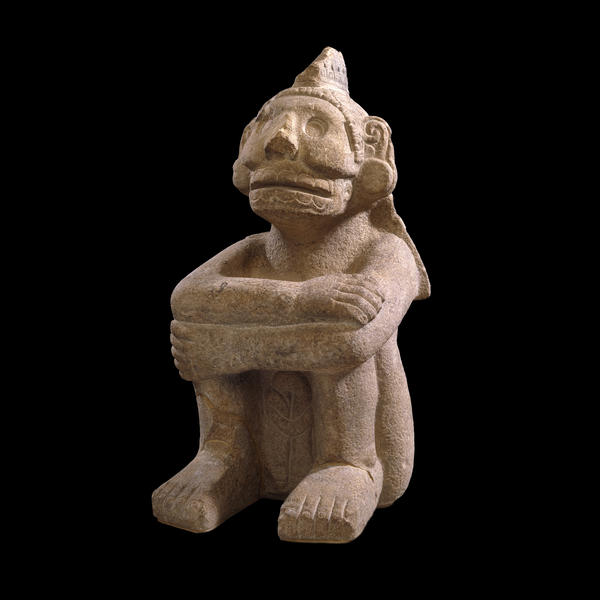
Sandstone seated figure of Mictlantecuhtli
Aztec, AD 1325-1521
From Mexico
This sculpture represents Mictlantecuhtli, an Aztec god associated with death. It is made from a sandstone which is not found in the Mexican highlands and was probably obtained in Veracruz. The figure bears three glyphs, carved on his back: 'Two Skull', 'Five Vulture' and 'Four House'.
Mictlantecuhtli, and his counterpart Mictlancihuatl, inhabited the lowest of the nine levels in which the Underworld (Mictlan) was divided. The 'soul' of the deceased went to a particular level in Mictlan according to the circumstances of their death. Those who died of natural causes went to the ninth level and had to negotiate all sorts of obstacles to reach it.
To help the 'souls' in their dangerous journey the deceases were cremated with some of their possessions, especially the tools they used in life.
Two spectacular ceramic figures of Mictlantecuhtli were recovered in the 1980s from the 'House of the Eagles', a building located in the Sacred Precinct of the Aztec capital, Tenochtitlan. These colossal figures had traces of blood on them. This is consistent with depictions in the codices (screenfold books) of ceremonies in which an image of Mictlantecuhtli, or a person representing him, is bathed with blood.
----------
Tlaloc
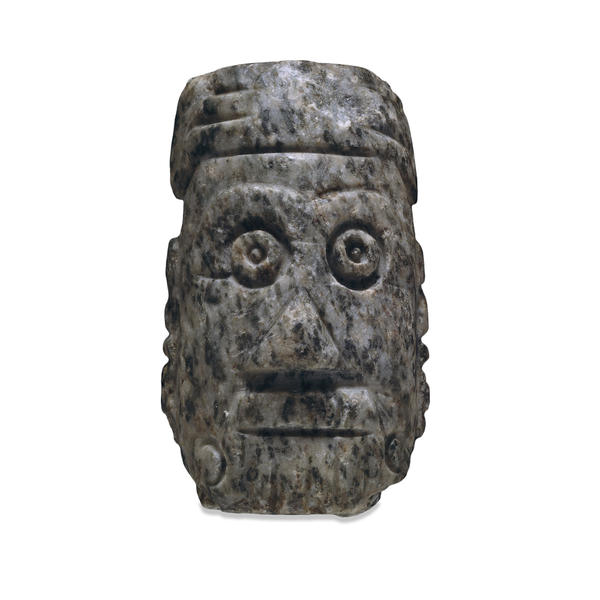
Head of Tlaloc, Mixtec, AD 1200-1521, From Mexico - BM
"This head represents the Rain God, Tlaloc, an important god in the Mesoamerican pantheon. Tlaloc can be recognized by the 'goggle' eyes and the fangs coming out of his mouth. Figurines similar to this piece, have been found as offerings in one of the twin shrines dedicated to Tlaloc at the Templo Mayor (Great Temple) of Tenochtitlan, the Aztec capital. Blue vessels and greenstone beads were also found around the shrine, symbolizing the water poured over the earth by the Rain Gods.
Images of Tlaloc are found in pottery, stone, mural painting and codices. He is usually associated with the colour blue, as can be seen, for example, on the Codex Magliabecchiano and mural paintings at Teotihuacan.
The role of Tlaloc in agriculture is vital: he ensures the timely rains and the growth of the crops, but he can also provoke floods and storms. His feminine counterpart is Chalchiuhtlicue, associated with the spring water, rivers and lakes. The Tlaloques, his attendants, were each associated with a mountain, the place where storms are born. " British Museum.
Height: 8.3 cm
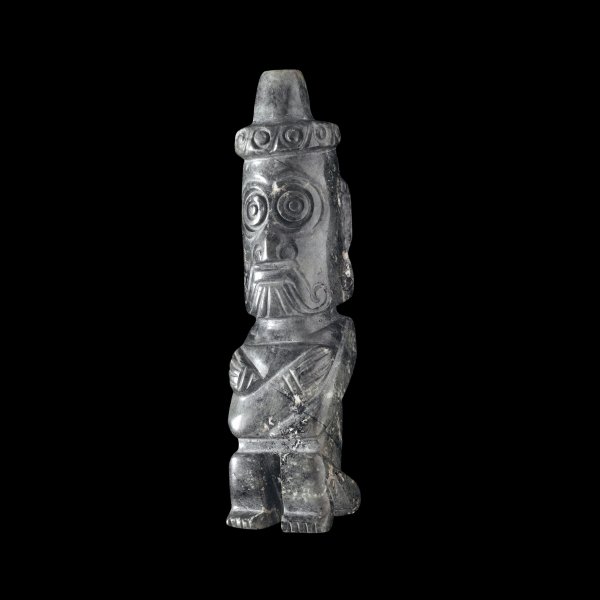
Also Tlaloc, approx same period.
Chalchiuhtlicue
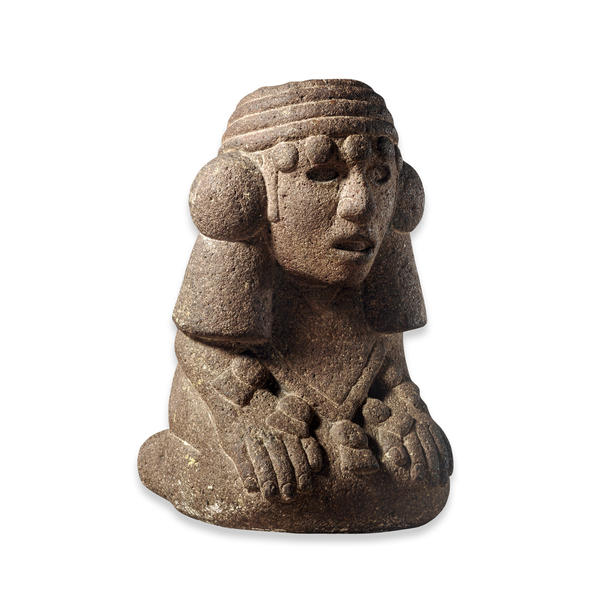
Stone kneeling figure of Chalchiuhtlicue
Aztec, AD 1325-1521
From Mexico
A water goddess
This stone sculpture represents Chalchiuhtlicue, the Aztec water goddess. Chalchiuhtlicue means 'she of the jade skirt' in Nahuatl, the language spoken by the Aztecs. She was associated with the spring water, rivers and lakes, and also with birth. According to an Aztec creation myth there were four suns (or worlds) before the present one. Chalchiuhtlicue presided over the fourth one, which was destroyed by floods and its people turned into fishes.
Female figurines, kneeling or standing, are a recurring theme in Aztec sculpture. Most of then have distinctive characteristics that identify them as fertility goddesses. They are always represented as young women and they wear a variety of headdresses. In some cases, like in this example, their hair is arranged in two large tassels on both sides of the head. Other fertility deities, such as the maize goddesses, wear a large rectangular headdress made of rigid bark paper and ornamented with rosettes. Here, Chalchiuhtlicue wears the traditional shawl (quechquemitl), also trimmed with tassels, over a long skirt. Her eyes were probably made of shell, like in many other Aztec sculptures.
-----
Also particularly shocking for the Spanish:
http://www.windows.ucar.edu/tour/link=/mythology/coyolxauhqui_moon.html&edu=high
Huitzilopochtli ... god of war, required sacrifices
http://www.windows.ucar.edu/tour/link=/mythology/huitzilopochtli_sun.html&edu=high
Aztec Writing
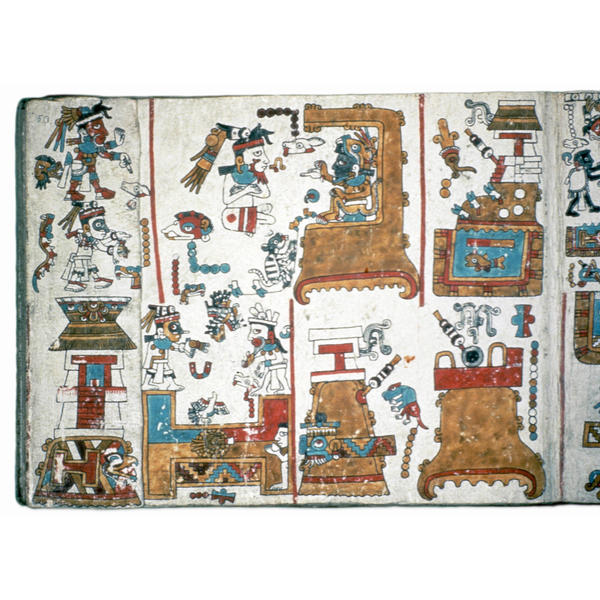
Above: Aztec type of writing.
Codex Zouche-Nuttall,
Mixtec, Late Postclassic period (AD 1200-1521),
From Mexico. British Museum.
"This is one of a small number of known Mexican codices (screenfold manuscript books) dating to pre-Hispanic times. It is made of deer skin and comprises 47 leaves. The Codex contains two narratives: one side of the document relates the history of important centres in the Mixteca region, while the other, starting at the opposite end, records the genealogy, marriages and political and military feats of the Mixtec ruler, Eight Deer Jaguar-Claw. This ruler is depicted at top centre, next to his calendric name (8 circles and a deer's head).
Very few Mesoamerican pictorial documents have survived destruction and it is not clear how the Codex Zouche-Nuttall reached Europe. In 1859 it turned up in a Dominican monastery in Florence. Years later, Sir Robert Curzon, 14th Baron Zouche (1810-73), loaned it to The British Museum. His books and manuscripts were inherited by his sister, who donated the Codex to the Museum in 1917. The Codex was first published by Zelia Nuttall in 1902." - BM
Aztec Conventions of Representation in the Codex Mendoza
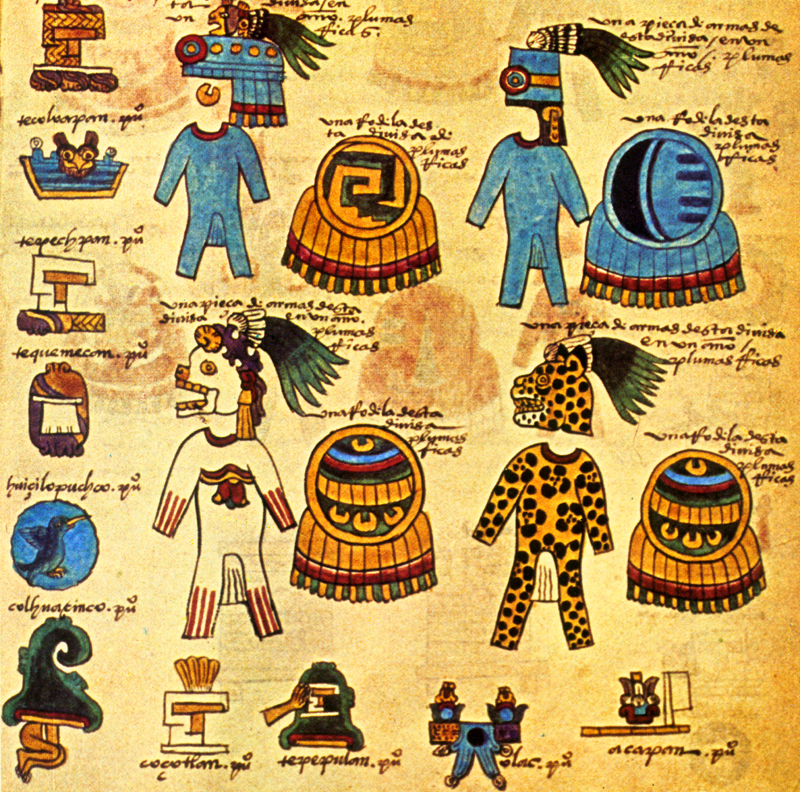
Image from: Ross, Kurt. 1978. Codex Mendoza: Aztec Manuscript, with commentary. Miller Graphics. p 41
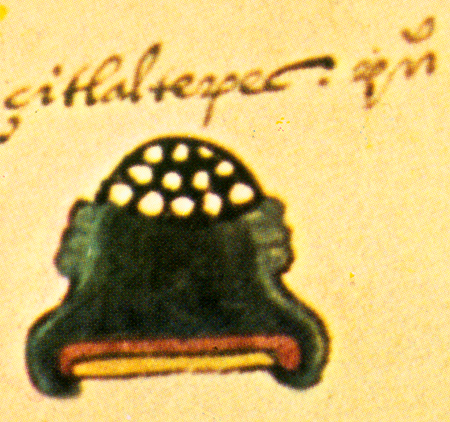
Image from: Ross, Kurt. 1978. Codex Mendoza: Aztec Manuscript, with commentary. Miller Graphics. p 38
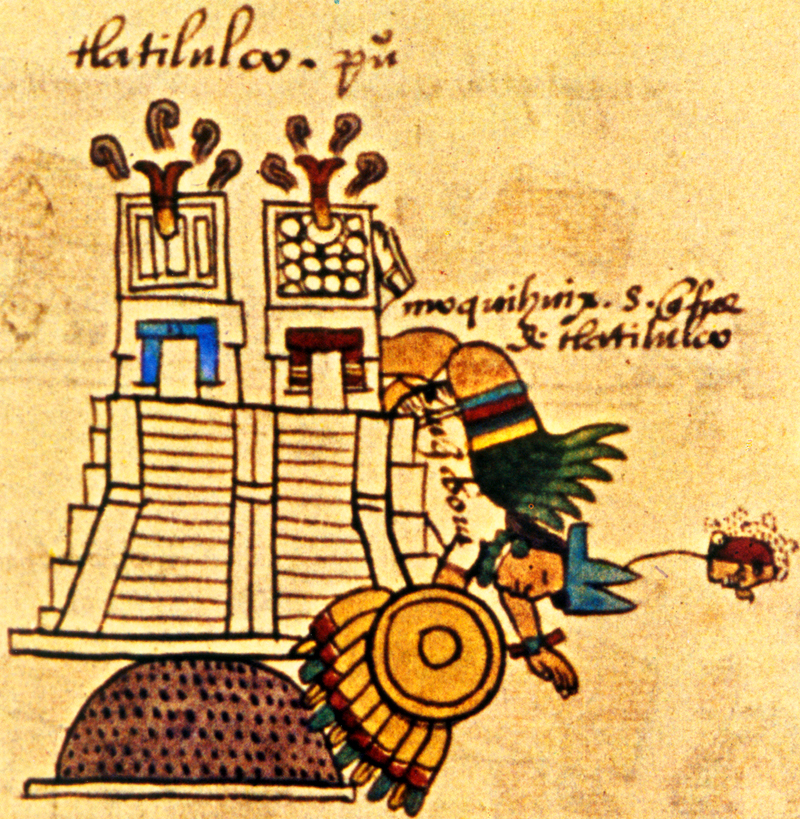
Image from: Ross, Kurt. 1978. Codex Mendoza: Aztec Manuscript, with commentary. Miller Graphics. p 28
video: THE FIVE SUNS: A SACRED HISTORY OF MEXICO 1996, 55 MIN. YORK VID #5381
Aztec cosmology... http://wwwuser.gwdg.de/~agruens/aztec/relignat.html
Consider:
Compare the Aztec creation story and the creation story of a religion you know -- what are the similarities and differences? Are there common themes? Common details?
How can creation stories relate to social ideologies, to power, to material culture and architecture, and to action?
Links:
VIDEO: Conquistadors.... we'll be watching this in tutorial....
http://www.pbs.org/conquistadors/
Episode: The Fall of the Aztecs: http://www.pbs.org/conquistadors/cortes/cortes_flat.html
Sister Stories: an experimental hypertext drawing upon Aztec life: www.nyupress.org/sisterstories/index.html
The Templo Mayor, Mexico City/Tenochtitlan http://archaeology.la.asu.edu/tm/index2.htm
Timothy Roufs' course site: www.d.umn.edu/cla/faculty/troufs/anth3618/maaztec.html
British Museum www.thebritishmuseum.ac.uk/compass/index.html search using "Aztec" for views of artifacts
Map of Tenochtitlan: http://geoimages.berkeley.edu/geoimages/Alonso_Map/NaviAlonso/alonso.html
Tenochtitlan: www.metmuseum.org/toah/hd/teno_1/hd_teno_1.htm
Teotihuacan: www.metmuseum.org/toah/hd/teot/hd_teot.htm
Ancient American Art: www.metmuseum.org/toah/hi/st_ancient_american_art.htm
Timelines of ancient art and culture: specifically Mexico www.metmuseum.org/toah/ht/07/cam/ht07cam.htm ( Other cultures: http://www.metmuseum.org/toah/splash.htm )